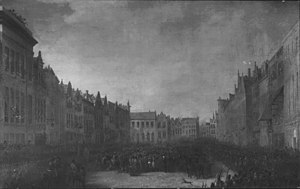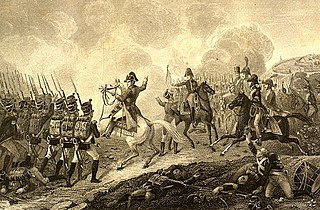
In the Battle of Lützen, Napoleon I of France defeated an allied army of the Sixth Coalition.

The Battle of Aldenhoven or Battle of the Roer saw a Republican French army commanded by Jean Baptiste Jourdan defeat a Habsburg army under François Sébastien Charles Joseph de Croix, Count of Clerfayt which was defending the line of the Roer River. A key crossing was won by the French right wing at Düren after heavy fighting. The Austrian retreat from the Roer conceded control of the west bank of the Rhine River to France. The battle occurred during the War of the First Coalition, part of a wider conflict called the Wars of the French Revolution. Aldenhoven is located in the state of North Rhine-Westphalia in Germany about 21 kilometres northeast of Aachen.

The Battle of Brienne saw an Imperial French army led by Emperor Napoleon attack Prussian and Russian forces commanded by Prussian Field Marshal Gebhard Leberecht von Blücher. After heavy fighting that went on into the night, the French seized a château, nearly capturing Blücher. However, the French were unable to dislodge the Russians from the town of Brienne-le-Château. Napoleon himself, making his first appearance on a battlefield in 1814, was also nearly captured. Very early the next morning, Blücher's troops quietly abandoned the town and retreated to the south, conceding the field to the French.

Jean-Baptiste Jourdan, 1st Count Jourdan, was a French military commander who served during the French Revolutionary Wars and the Napoleonic Wars. He was made a Marshal of the Empire by Emperor Napoleon I in 1804. He was also a Jacobin politician during the Directory phase of the French Revolution, serving as member of the Council of Five Hundred between 1797 and 1799.

The Battle of La Rothière was fought on 1 February 1814 between the French Empire and allied army of Austria, Prussia, Russia, and German States previously allied with France. The French were led by Emperor Napoleon and the coalition army was under the command of Gebhard Leberecht von Blücher. The battle took place in severe weather conditions. The French were defeated but managed to hold until they could retreat under cover of darkness.

The city of Hamburg was one of the most powerful fortresses east of the Rhine. After being freed from Napoleonic rule by advancing Cossacks and other following Coalition troops it was once more occupied by Marshal Davout's French XIII Corps on 28 May 1813, at the height of the German Campaign during the War of the Sixth Coalition from French rule and occupation. Ordered to hold the city at all costs, Davout launched a characteristically energetic campaign against a similar numbered Army of the North made up of Prussian and other Coalition troops under the command of Count von Wallmoden-Gimborn, winning a number of minor engagements. Neither force was decidedly superior and the war ground to a halt and resulted in a rather stable front line between Lübeck and Lauenburg and further south along the Elbe river, even after the end of the cease-fire of the summer 1813. In October 1813 a French column's movement towards Dannenberg resulted in the only major engagement in Northern Germany, the Battle of the Göhrde. The defeated French troops retreated back to Hamburg.

The Battle of Bayonne saw the French garrison of Bayonne led by General of Division Pierre Thouvenot launch a sortie against a besieging force of British, Portuguese, and Spanish troops commanded by Lieutenant General John Hope. The fighting marked the last major battle of the Peninsular War and occurred after unofficial news of Napoleon's 4 April abdication reached the opposing forces. Thouvenot's reasons for initiating the sortie are not clear because there was apparently nothing for the French to gain by fighting. After the French enjoyed initial success, Allied forces drove them back inside Bayonne with heavy losses on both sides.

The Battle of Saint-Dizier was fought on 26 March 1814, between the Russian Army under Ferdinand Wintzingerode and The French Army, also known as ‘La Grande Armée’ commanded by Napoleon Bonaparte. The battle was part of Napoleon's Campaign of France, which took place during the War of the Sixth Coalition. It was Napoleon's last military victory before the surrender of Paris and his subsequent abdication.

The Battle of Ostrołęka was fought on 16 February 1807 between a French force under General of Division Anne Jean Marie René Savary and a Russian force under Lieutenant General Ivan Essen. The French defeated the Russians and forced them to retreat to the east to Wyoki Mazowiecki. Weather conditions caused both sides to go into winter quarters immediately after the battle, which occurred during the War of the Fourth Coalition, part of the Napoleonic Wars. Ostrołęka is located in the northeast part of modern Poland, but in 1807 it belonged to the Kingdom of Prussia.
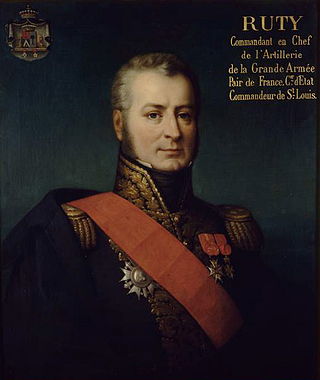
Charles-Étienne-François de Ruty (1774–1828), count, was a French artillery officer during the French Revolutionary Wars and Napoleonic Wars, who rose to the rank of general of division, state counsellor (1818) and Peer of France from 1819.
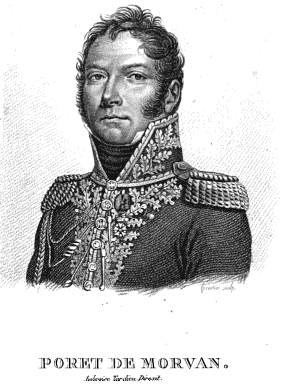
Paul-Jean-Baptiste Poret de Morvan, baron of the Empire, was a French officer during the French Revolutionary Wars and Napoleonic Wars, who rose to the rank of general.

The siege of Magdeburg took place from 25 October to 8 November 1806 during the War of the Fourth Coalition. A French force, initially under the command of Marshal Joachim Murat, then a French army Corps under the command of Marshal Michel Ney laid siege and eventually obtained the surrender of Franz Kasimir von Kleist's Prussian force that had taken refuge in Magdeburg, Prussia's second city.
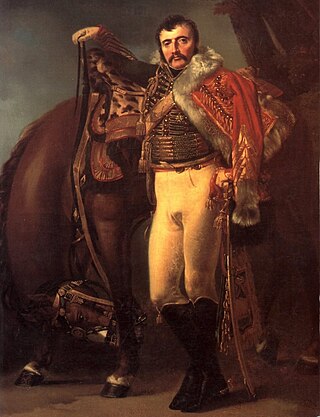
Claude-Étienne Guyot, count of the Empire, (1768–1837) was a French general of the French Revolutionary Wars and Napoleonic Wars, noted for commanding cavalry.

In the siege of Tarragona, Catalonia, from 5 May to 29 June 1811, Louis Gabriel Suchet's French Army of Aragon laid siege to a Spanish garrison led by Lieutenant General Juan Senen de Contreras. A British naval squadron commanded by Admiral Edward Codrington harassed the French besiegers with cannon fire and transported large numbers of reinforcements into the city by sea. Nevertheless, Suchet's troops stormed into the defenses and killed or captured almost all the defenders. The action took place at the port of Tarragona, Catalonia, on the east coast of Spain during the Peninsular War, part of the Napoleonic Wars.
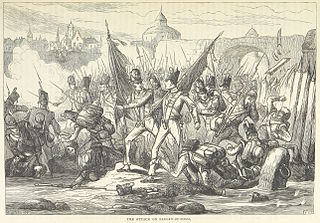
The siege of Bergen op Zoom, took place during the War of the Sixth Coalition between a British force led by Thomas Graham, 1st Baron Lynedoch and a French garrison under Guilin Laurent Bizanet and Jean-Jacques Ambert. The initial British assault force seized part of the defences, but a well-managed French counterattack compelled much of the assault force to surrender. Bergen op Zoom is a port in the Netherlands about 70 kilometres (43 mi) south of Rotterdam and 40 kilometres (25 mi) north of Antwerp in Belgium.
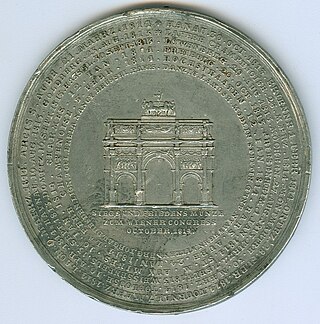
The Battle of Hoogstraten was fought on 11 January 1814 between a French army, led by François Roguet, and a Russo-Prussian-British army, led by Friedrich Wilhelm Freiherr von Bülow. The battle, which ended in a Prussian victory, consisted of a series of engagements situated between Essen and Turnhout. The battle was named after Hoogstraten, the main town of the Kempen region.

The Battle of Limonest saw 30,000-53,000 Austrian and Hessian troops led by Prince Frederick of Hessen-Homburg defeat 20,000-23,000 French troops under Marshal Pierre Augereau.

The Battle of Mâcon saw a French division under Louis François Félix Musnier attack an Austrian corps led by Frederick Bianchi, Duke of Casalanza. The French enjoyed initial success but their numerical inferiority led to their defeat in this War of the Sixth Coalition clash. Mâcon is located 72 kilometres (45 mi) north of Lyon.
The Battle of Courtrai saw Johann von Thielmann's Kingdom of Saxony troops and a few Prussians encounter an Imperial French force under Nicolas Joseph Maison near Kortrijk (Courtrai), a city south-west of Ghent in what is now Belgium. Thielmann attacked only to find himself facing the bulk of Maison's I Corps. The action ended in a rout of the Saxons, most of whom were under fire for the first time.
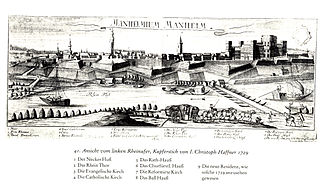
The action at Mannheim began in April 1795 when two French armies crossed the Rhine and converged on the confluence of the Main and the Rhine. Initial action at Mannheim resulted in a minor skirmish, but the Bavarian commander negotiated a quick truce with the French and withdrew. On 17 October 1795, 17,000 Habsburg Austrian troops under the command of Dagobert Sigmund von Wurmser engaged 12,000 soldiers, led by Jean-Charles Pichegru in the grounds outside the city of Mannheim. In a combination of maneuvers, the Habsburg army forced 10,000 of the French forces to withdraw into the city itself; other French troops fled to join neighboring Republican armies. First Coalition forces then laid siege to Mannheim. Subsequent action at neighboring cities forced the French to withdraw further westward toward France; after a month's siege, the 10,000-strong Republican French garrison now commanded by Anne Charles Basset Montaigu surrendered to 25,000 Austrians commanded by Wurmser. This surrender brought the 1795 campaign in Germany to an end. The battle and siege occurred during the War of the First Coalition, part of the French Revolutionary Wars. Situated on the Rhine River at its confluence with the Neckar River, Mannheim lies in the federal state of Baden-Württemberg in modern-day Germany.
